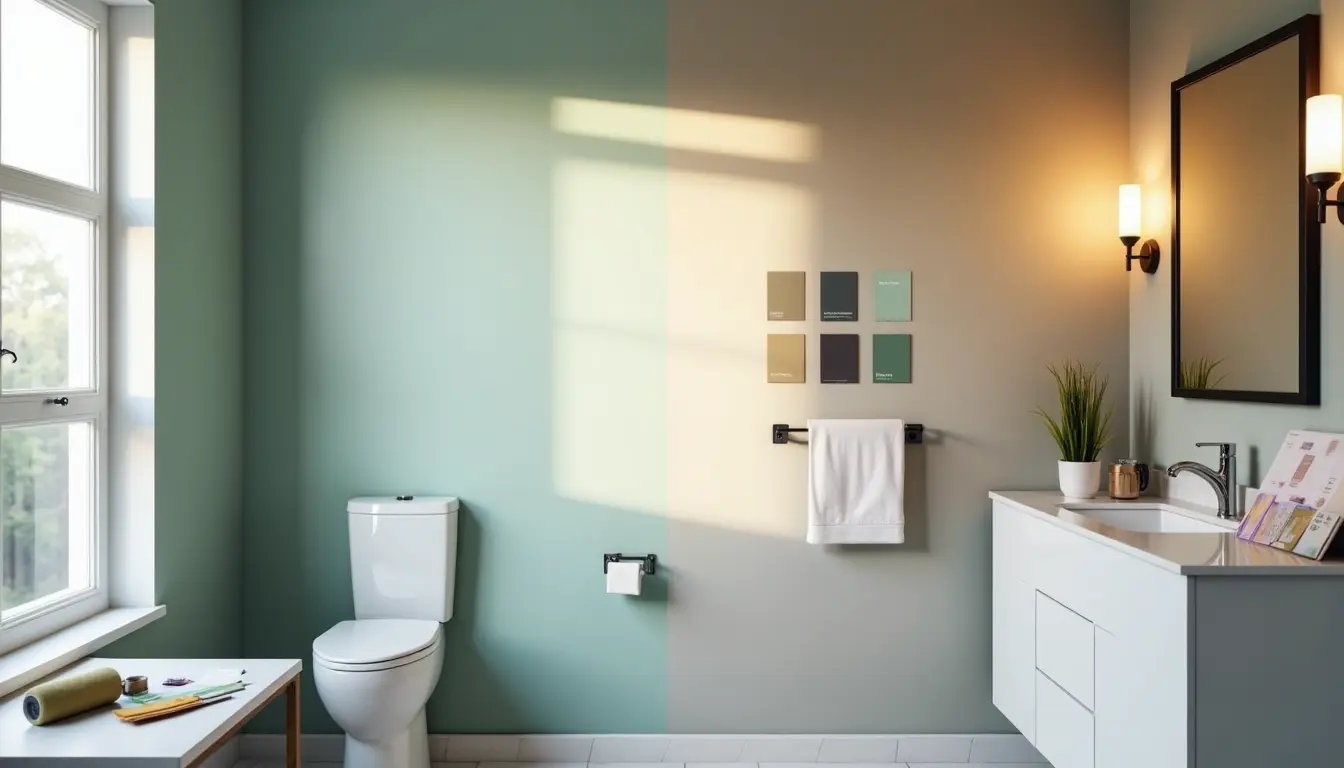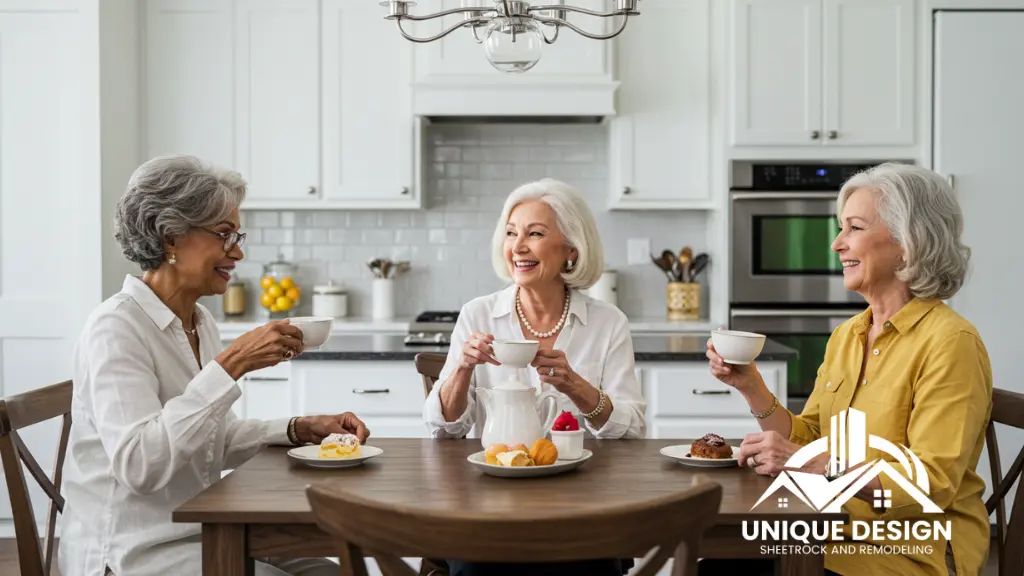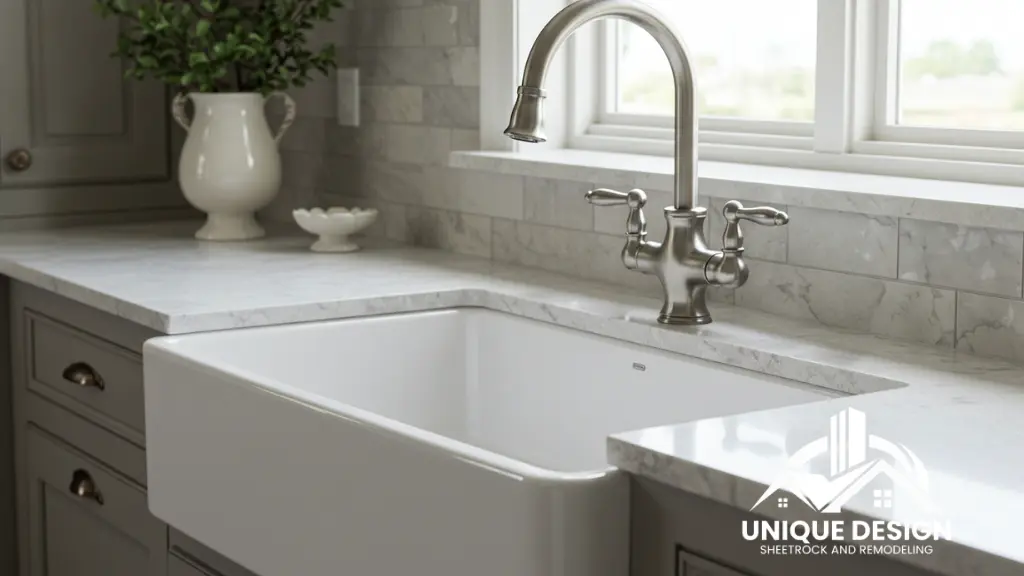
Bathroom Paint Colors: What Interior Designers Don't Tell You
Paint colors in your bathroom affect your home's value by a lot. The National Association of Realtors®️ reports that bathroom renovations offer a 71% cost recovery, which makes your color selection a vital factor.
Paint colors appear different under natural and artificial light when designing a spa-like master bath or bold powder room. Experience shows that neutral paint colors attract many homeowners. Small bathrooms provide perfect opportunities to try bolder choices.
Interior designers have some lesser-known secrets about bathroom color selection. The practical 70-20-10 color rule and natural light's effects shape your space's character. These insights help you dodge common mistakes and pick colors that match your style and your bathroom's unique requirements.
The Truth About Neutral Bathroom Colors
Interior designers often suggest neutral bathroom paint colors. These shades create a clean, relaxed environment that's perfect for a minimalist or spa-like retreat. Notwithstanding that, there's more to this choice than you might think.
Why designers suggest neutral colors
Neutral colors stay popular because they are a great way to get versatility with bathroom fixtures and materials. On top of that, these shades help make smaller bathrooms appear more spacious and open. Light-colored neutrals reflect more light naturally and create an illusion of expanded space, especially when you have compact bathrooms.
Designers love neutral tones as they create the perfect backdrop for design elements. These colors go together with different textures like wood, natural stone, and chrome fixtures. Neutral bathrooms also keep their appeal as design trends change, from contemporary to traditional styles.
Hidden drawbacks of neutral shades
Neutral bathroom paint colors might be popular, but they come with challenges designers rarely talk about. Here are the biggest problems to think over:
- White and light neutrals show every imperfection, including soap scum and water spots
- Neutral walls look bland without proper texture variation
- Some neutral shades, mostly white, can turn yellow from moisture and high temperatures
- Light beige tones can make a bathroom look outdated if not chosen carefully
Lighting affects neutral shades in ways people often miss. Natural light changes how these colors look throughout the day. A neutral tone that looks perfect in morning light might seem completely different under evening artificial lighting.
Upkeep is another challenge you'll face. Neutral-colored bathrooms just need more frequent cleaning to stay fresh. Light shades show dirt, stains, and wear patterns more easily over time.
You can make neutral bathroom paint colors work by adding different textures and patterns. This keeps the space from feeling boring while keeping that calming effect that makes neutrals so appealing. Try mixing different neutral shades - like soft whites with warm grays or beiges - to create depth and visual interest without losing the peaceful atmosphere.
Lighting Changes Everything
Light plays a significant part in how we see bathroom paint colors throughout the day. Paint shades can look dramatically different as natural and artificial light conditions change. This makes lighting a vital factor to think over for successful bathroom design.
Morning vs evening light effect
Natural light changes how bathroom paint colors look as the day moves along. The original morning light brings a warm, yellowish glow that makes warm-toned paints pop. The same wall color might look cooler and more washed out during midday when rooms get direct sunlight. Evening light casts a reddish tone that can make warm paint colors more intense.
Your bathroom's direction changes how paint colors look. Bathrooms facing north get soft, steady light that can make dark colors appear darker. Rooms facing south get intense light that brightens dark shades and might wash out lighter colors.
Artificial lighting tricks
The artificial lights you pick can make your bathroom paint colors look better or completely different. Here's what different bulbs do to color:
- Warm LED bulbs (2700K-3000K): Give a cozy, relaxing feel that works great for evening baths
- Cool LED bulbs (3500K-4000K): Give bright, clean light that's perfect for morning routines
- Halogen bulbs: Create yellow light that makes warm colors pop but dulls cooler shades
- Fluorescent lighting: Makes cool, blue light that brings out blues and greens
Neutral white bulbs that copy daylight are best to see true colors. Adding dimmers lets you adjust light levels through the day, giving you control over how your paint colors look.
Window placement effects
Careful window placement can change how bathroom paint colors look. Big windows let in more natural light, which helps colors look more vibrant and true. A 4' by 4' fixed glass window above a tub works great.
Mirrors placed across from windows multiply natural light and create a brighter space that changes how colors look. Windows between vanity sinks or near makeup spots are great because they provide natural light you need for daily grooming.
The height of bathroom windows matters too. The best setup puts the window head level with the mirror's top while leaving room for lights above or on both sides. This setup will give balanced lighting that shows paint colors accurately throughout the space.
Paint Finish Secrets
Your choice of paint finish can make or break your bathroom walls' resistance to moisture and daily wear. Experience has taught me that paint sheen plays a bigger role than color in making your bathroom last longer.
Why sheen matters more than color
Paint finish acts as a shield against moisture and that's vital for bathrooms. Semi-gloss and satin finishes really shine here. We tested these finishes and found they keep water out and stop mold from growing. They create a hard, shiny surface that blocks moisture from getting into your walls.
Here's what you need to know about bathroom paint finishes:
- Semi-gloss: Gives you the best moisture resistance and durability - perfect for full bathrooms with showers
- Satin: Shows a subtle sheen and good moisture resistance, works great in powder rooms
- Gloss: Delivers maximum shine and strongest moisture barrier, ideal for trim and splash-prone areas
- Eggshell: Works only in low-moisture powder rooms without showers
Paint with higher sheen levels fights water damage and stains better. Flat or matte finishes are nowhere near suitable for bathrooms since they soak up moisture instead of blocking it. This trapped moisture leads to mold and peeling paint.
Your choice of finish affects both durability and cleanup. Semi-gloss and satin finishes wipe clean easily, which means less work for you over time. These surfaces keep looking fresh even after you clean them repeatedly.
Different spots in your bathroom might need different finishes. To name just one example, see how walls near sinks or tubs need higher-sheen finishes because they get splashed more. You can use satin finishes in drier areas to add visual interest while keeping walls protected.
Bathroom size should guide your finish selection. Higher-sheen finishes bounce more light around and make smaller bathrooms look bigger. But remember that glossier finishes tend to show every bump and dent in your walls, so you'll need to prep surfaces carefully.
Bathroom-specific paints that combine the right sheen with mold-fighting properties give you the best results. These special formulas protect against humidity and temperature swings to keep your bathroom walls looking great year after year.
Color Psychology in Bathrooms
Bathroom colors play a powerful role in shaping our mental state and daily routines. These paint colors affect us way beyond their visual appeal and shape our mood while contributing to our mental well-being.
Morning energy colors
Your morning routine gets a boost from bright, invigorating shades. Yellow emerges as a powerful morning energizer - research shows it stimulates serotonin production and gives an instant mood boost. Vibrant yellows and oranges create a lively and uplifting bathroom atmosphere that sets a positive tone for your day.
These energizing options work great for morning spaces:
- Bright yellows: Associated with sunshine and positive energy, perfect for stimulating morning alertness
- Warm oranges: Create an inviting, energetic atmosphere ideal for morning routines
- Vibrant greens: Promote feelings of harmony while maintaining an energizing effect
Relaxing evening shades
Evening relaxation needs a different color approach. Cool tones like blues and greens create a calming sanctuary because they remind us of natural elements like water and sky. Research shows that exposure to blue can lower blood pressure and reduce stress levels.
Soft blues and muted greens top the list of relaxing shades. Their connection to nature promotes tranquility. Purple tones have shown promise in lowering stress hormones, making them perfect for evening relaxation.
The time of day shapes how we notice and respond to bathroom colors. Cool colors make the space look bigger while creating an open feeling. Warm colors can reshape your bathroom into a cozy retreat that's perfect for unwinding.
Your bathroom's main usage time should guide your color choice. A master bathroom used mostly in mornings benefits from energizing tones. Bathrooms used mainly for evening relaxation need calming shades. This thoughtful approach to color selection helps your space support your daily routine and emotional well-being.
Hidden Costs of Trendy Colors
Trendy bathroom paint colors can get pricey in ways many homeowners only realize after they finish painting. The cost goes way beyond the original paint price and application fees, as these fashionable choices create unexpected financial obligations.
Maintenance requirements
Trendy bathroom paint colors are nowhere near as easy to maintain as traditional choices. Light colors tend to show stains and dirt more easily, and you just need to clean them more often to keep them looking good. Bold and vibrant colors require extra attention to stop them from fading and to keep their dramatic effect.
A fresh-looking trendy bathroom needs:
- Regular checks for mold or wear, especially in damp areas
- Deep cleaning to avoid discoloration
- Touch-ups to keep the color even
- Extra care around sinks and showers where water splashes most
Paint quality makes a big difference in how much maintenance you'll do. Better paint formulas resist moisture better and don't wear down as fast. You might save money upfront with cheaper paint, but it usually means more maintenance costs and frequent touch-ups later.
Repainting frequency
Your bathroom's repainting schedule is different from other rooms in your house. Bathrooms typically need repainting every three to four years, though this timeline changes based on several things. Shower and bath moisture speeds up the need to repaint.
Trendy designs often push you to repaint more often as styles change. These quick-changing trends can get pricey and time-consuming. Sometimes you might even need a complete redesign to stay current. This creates a substantial financial effect since you'll have to buy new materials and pay for specialized installation as trends change.
Your bathroom paint's lifespan depends on several factors. Busy bathrooms might need fresh paint every 2-3 years. Powder rooms with less moisture can go longer between paint jobs. Homes with good ventilation and moisture control might see their paint last longer.
Paint quality plays a vital role in how often you'll need to repaint. Premium paints with mildew-resistant coatings last longer and resist peeling, cracking, and fading. These high-end options cost more upfront but reduce how often you need to repaint.
To name just one example, see how understanding maintenance and repainting needs helps plan your budget when picking trendy bathroom colors. The real cost goes beyond buying the paint. You'll need regular upkeep, possible touch-ups, and more frequent complete repaints than with classic color choices.
Common Color Mistakes
Smart bathroom paint color decisions depend on understanding how space works with existing elements. Many homeowners end up making pricey mistakes because they overlook factors that affect their color choices.
Overlooking room size
Paint colors appear and feel different based on room dimensions. Bold shades that look stunning in a spacious master bathroom might overwhelm a powder room. Dark colors can make small bathrooms look garish. These same shades create a cozy atmosphere when used on larger space ceilings.
Your bathroom's size should guide paint color selection:
- Bright, powerful colors tend to make rooms appear smaller
- Pastel shades naturally create an illusion of more space
- Deeper colors can add visual depth when used strategically
- Light colors reflect more light and expand space
Ignoring fixed elements
Homeowners often fail to think over their bathroom's permanent features. We used elements like cabinets, tile flooring, and metal hardware to create a foundation that must work with the chosen paint color. These fixed components will determine your color palette's success.
Bathrooms come with unique challenges due to their many non-movable fixtures. Success lies in spotting common elements among existing features. To cite an instance, see if fixtures share similar tones or metals match to create a cohesive look.
Tile color affects the room's size and functionality substantially. Light-colored tiles with complementary wall colors can brighten small bathrooms. Darker combinations create an intimate atmosphere.
Paint colors and existing features need to work together seamlessly. A vanity's finish might clash with certain wall colors and disrupt the room's visual harmony. Fixed elements and paint choices become even more important in bathrooms with limited natural light.
Your bathroom's permanent features should guide paint color selection. This method will give you a chosen shade that works with existing elements instead of fighting against them. Note that these fixed items will stay constant unless you plan a complete remodel, making them your color scheme's foundation.
Testing Colors Like a Pro
Professional paint testing techniques will change how your bathroom paint colors look in ground conditions. Small paint swatches from stores rarely show you the full picture of how a color will look in your space.
Large sample technique
Testing paint colors with small swatches or painting directly on walls has major drawbacks. We recommended creating oversized paint samples on poster board or foam core that measure at least one foot by one foot. These larger samples give you a much better idea of how the color will actually look in your space.
You need these key steps to create good test samples:
- Paint two complete coats on your sample board to get true color
- Use double-sided tape to stick samples to walls so you can move them easily
- Keep a white border around each sample so existing wall colors don't affect what you see
Some paint manufacturers now offer large peel-and-stick samples that measure 9" x 14.75". These pre-painted samples let you test colors without making a mess.
Time of day testing
You need a step-by-step plan to test paint colors at different times. Colors look dramatically different as lighting changes throughout the day. To get a full picture of a paint color, look at your samples in these specific situations:
Your chosen color might look washed out or more intense near windows with bright natural light. Moving samples to different walls helps you understand how the paint looks in various lighting conditions. This testing process shows you how your paint choice works in every possible scenario.
The best results come from leaving your samples in place for several days. This longer observation time lets you see how the color responds to:
- Morning sunlight conditions
- Midday brightness levels
- Evening artificial lighting
- Overcast weather variations
The current wall color can really change how new paint samples look. Colors appear darker against light backgrounds and lighter against dark surfaces. This helps you make better decisions about your final color choice.
Put samples near vanities, tiles, and fixtures when testing bathroom paint colors. This way you'll know your chosen color goes together with existing bathroom features. Testing samples at different wall heights shows you how shadows and reflections might affect the overall look.
Color consultants stress how important artificial lighting is in your testing process. Your bathroom's lighting fixtures change how paint colors look, especially at night. Test your samples with the exact type of bulbs you plan to use because different bulb temperatures can really change how colors look.
Long-term Color Planning
Paint colors do more than just make your bathroom look good. They can make a big difference in your home's long-term value. Research shows that smart color choices will affect your home's resale potential. This makes color selection more than just a matter of taste.
Resale value impact
Zillow's largest longitudinal study on paint colors shows how bathroom colors can affect home values. Light blue bathrooms, especially those with periwinkle shades, can boost a home's value by 1.6%. A $290,000 home could gain nearly $5,000 in value just from this choice.
Some color choices might hurt your home's value. Buyers tend to shy away from bright, bold colors. White bathrooms, which many people think are a safe bet, can actually lower home value by $4,035. This finding challenges what we thought we knew about neutral colors.
These color choices will boost your home's appeal to buyers:
- Soft gray-blue combinations give a sophisticated look
- Light periwinkle adds maximum value
- Warm neutrals create timeless appeal
- Muted earth tones offer lasting style
Bathroom paint colors matter beyond just looks. A Zillow study of 32,000 home photos found that colors shape how buyers see your home and what they'll pay. Yellow and red tend to lower property values, though not as much as leaving walls unpainted.
Light reflective value (LRV) is vital in color planning. Paints with an LRV of at least 60 will give you the best resale potential. This technical detail helps keep your bathroom bright and airy - something buyers love.
Bathroom paints need to resist moisture and last long. High-quality, moisture-resistant paints ended up being worth more at resale. They keep looking fresh and fight off mold and mildew better.
Your local market affects how bathroom colors impact home value. Local real estate trends should guide your choices since regional tastes can sway buyer reactions. Real estate data shows that neutral and classic color schemes appeal to more buyers, which helps sell your home faster.
Colors must work well with your existing fixtures and materials. A unified color scheme that matches permanent bathroom features creates lasting appeal. This smart approach helps your bathroom stay valuable as design trends change.
Earth tones and natural colors will maximize your resale potential. These shades create an elegant, reliable look that strikes a chord with buyers who want timeless design. This balanced approach protects your investment and ensures good returns in the future.
Conclusion
Bathroom paint colors affect your daily life and your home's value. Light blue shades are the clear winners from my research. They can add $5,000 to your home's value. The paint finish you choose matters just as much. Semi-gloss and satin finishes will protect better against moisture and keep their look longer.
Smart color choices just need thorough testing in different lights. Small swatches won't tell the whole story. Large sample boards will show you how colors look throughout the day. This approach helps you avoid choices that get pricey and ensures you'll love your final pick.
Here's a tip: Think about what time you use your bathroom most. Bright yellows are great to wake up to, while cool blues create the perfect evening retreat. Since we're talking about beautiful designs, you might want to check out our beautiful kitchen designs at Texas Unique Design Remodeling to inspire your next project.
Paint colors revolutionize bathrooms into personal havens while protecting your investment. Trends change, but colors that work with your room's size, fixed elements, and lighting create lasting appeal. Note that successful bathroom design strikes the right balance between what you love now and what adds value later.
FAQs
Q1. What is the ideal paint finish for a bathroom? Semi-gloss and satin finishes are best for bathrooms. They offer superior moisture resistance, durability, and are easy to clean. Semi-gloss is ideal for full bathrooms with showers, while satin works well in powder rooms.
Q2. How does lighting affect bathroom paint colors? Lighting dramatically impacts how paint colors appear. Natural light changes throughout the day, while artificial lighting can alter color perception. It's crucial to test paint samples at different times of day and under various lighting conditions to ensure the color looks good in all scenarios.
Q3. Can bathroom paint colors affect home value? Yes, bathroom paint colors can significantly impact home value. Light blue shades, particularly periwinkle, have been shown to increase a home's value by up to 1.6%. Conversely, white bathrooms can actually decrease home value, challenging the assumption that neutral colors are always safe choices.
Q4. What's the best way to test bathroom paint colors? Create large paint samples on poster board or foam core, at least one foot square. Place these samples on different walls and observe them at various times of day for several days. This method provides a more accurate representation of how the color will look in your space compared to small paint swatches.
Q5. Should I choose energizing or relaxing colors for my bathroom? The choice between energizing and relaxing colors depends on when you primarily use the bathroom. For morning spaces, consider bright, invigorating shades like yellow or orange. For evening relaxation, opt for cool tones like soft blues or muted greens that promote tranquility.



